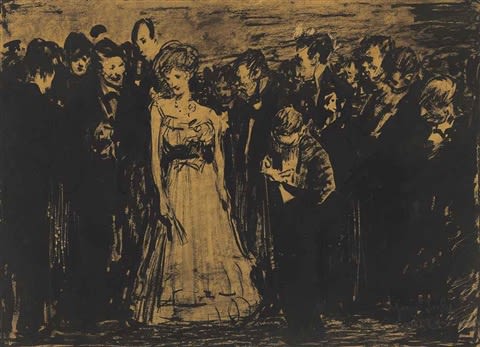George Bellows painted his final masterpiece, Dempsey and Firpo, in 1924. On January 8, 1925, Bellows died from a ruptured appendix. He was just 42 years old. Writer Sherwood Anderson said that Bellows’s last paintings “keep telling you things. They are telling you that Mr. George Bellows died too young. They are telling you that he was after something, that he was always after it.”
George Bellows’ Views of New York
George Bellows left his home state of Ohio in 1904. He had been a superb athlete and turned down an offer to play professional baseball to pursue a career in art. He studied with Robert Henri at the New York School of Art, which led to his becoming part of the Ashcan School, whose focus was painting scenes of daily life in America.
Unlike other members of the Ashcan School, Bellows had never traveled to Europe, or anywhere outside the U.S., to study art. His gift, along with being a masterful draftsman, was his ability to capture a scene and bring viewers to the works as impartial observers.
He also gave the world an historical portrait of life in early twentieth century New York. Bellows drew Election Night, Times Square in 1906, just two years after Times Square actually opened. The drawing was done on the night of the controversial gubernatorial election, which pit Democratic newspaper magnate William Hearst against Republican Charles Evan Hughes.
The atmosphere in Times Square that night was much the same as it is now on New Years Eve. Bands played, while newspapers projected cartoons and election results, which were transmitted by telegraph, onto big screens.
Although the newspapers reported the revelry, a close look at Bellows’ work shows people being beaten and molested by young thugs. Bellows’ work portrayed both the rough side and the appeal of New York. Hughes won the election. It was Bellows’ paintings of urban street life and boxing matches that brought him much attention.
Both Members of This Club is a large, (3′ 9″ x 5′ 3″) painting that references the Lewis Law of 1900 that banned public boxing matches in New York State. Boxing was a controversial subject in 1909, as was the interracial theme of the painting, a nod to the African-American boxer Jack Johnson, who had won the world heavyweight championship in 1908.
The Softer Side of George Bellows
George Bellows painted portraits, many of his wife and two daughters and other family members, and stunning land and seascapes.Bellows use of pen and ink led him explore lithography. He installed a lithography press in his studio. Because of Bellows skill and popularity, lithography gained acceptance as a fine art medium in the U.S.
George Bellows at Surovek Gallery
The Invincible Molly Brown was drawn by George Bellows as a wedding present for Jessie Brown, the central figure in the work. Standing behind Miss Brown is the artist himself. Robert Henri is on her right.
Please contact us if you would like more information about The Invincible Molly Brown or any of the fine art works available at Surovek Gallery.





